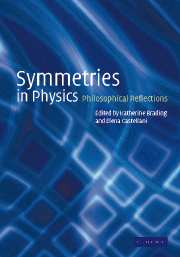Book contents
- Frontmatter
- Contents
- List of contributors
- Preface
- Copyright acknowledgements
- 1 Introduction
- Part I Continuous symmetries
- 2 Classic texts: extracts from Weyl and Wigner
- 3 On continuous symmetries and the foundations of modern physics
- 4 The philosophical roots of the gauge principle: Weyl and transcendental phenomenological idealism
- 5 Symmetries and Noether's theorems
- 6 General covariance, gauge theories, and the Kretschmann objection
- 7 The interpretation of gauge symmetry
- 8 Tracking down gauge: an ode to the constrained Hamiltonian formalism
- 9 Time-dependent symmetries: the link between gauge symmetries and indeterminism
- 10 A fourth way to the Aharonov–Bohm effect
- Part II Discrete symmetries
- Part III Symmetry breaking
- Part IV General interpretative issues
- Index
2 - Classic texts: extracts from Weyl and Wigner
Published online by Cambridge University Press: 08 October 2009
- Frontmatter
- Contents
- List of contributors
- Preface
- Copyright acknowledgements
- 1 Introduction
- Part I Continuous symmetries
- 2 Classic texts: extracts from Weyl and Wigner
- 3 On continuous symmetries and the foundations of modern physics
- 4 The philosophical roots of the gauge principle: Weyl and transcendental phenomenological idealism
- 5 Symmetries and Noether's theorems
- 6 General covariance, gauge theories, and the Kretschmann objection
- 7 The interpretation of gauge symmetry
- 8 Tracking down gauge: an ode to the constrained Hamiltonian formalism
- 9 Time-dependent symmetries: the link between gauge symmetries and indeterminism
- 10 A fourth way to the Aharonov–Bohm effect
- Part II Discrete symmetries
- Part III Symmetry breaking
- Part IV General interpretative issues
- Index
Summary
I think the real situation has to be described as follows. Relative to a complete system of reference not only the points in space but also all physical quantities can be fixed by numbers. Two systems of reference are equally admissible if in both of them all universal geometric and physical laws of nature have the same algebraic expression. The transformations mediating between such equally admissible systems of reference form the group of physical automorphisms; the laws of nature are invariant with respect to the transformations of this group. It is a fact that a transformation of this group is uniquely determined by that part of it that concerns the coordinates of space points. Thus we can speak of the physical automorphisms of space. Their group does not include the dilatations, because the atomic laws fix an absolute length, but it contains the reflections because no law of nature indicates an intrinsic difference between left and right. Hence the group of physical automorphisms is the group of all proper and improper congruent mappings. If we call two configurations in space congruent provided they are carried over into each other by a transformation of this group, then bodies which are mirror images of each other are congruent. I think it is necessary to substitute this definition of congruence for that depending on the motion of rigid bodies, for reasons similar to those which induce the physicist to substitute the thermodynamical definition of temperature for an ordinary thermometer.
- Type
- Chapter
- Information
- Symmetries in PhysicsPhilosophical Reflections, pp. 21 - 28Publisher: Cambridge University PressPrint publication year: 2003



